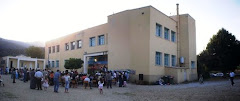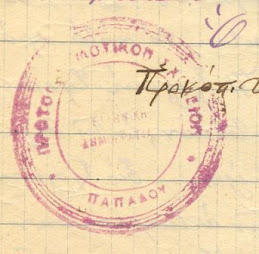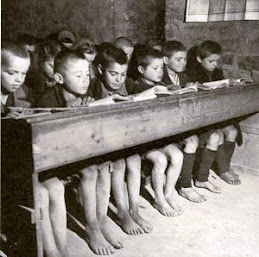COMENIUS PARTNERSHIPS
Education and Culture
Lifelong Learning Program
Title of the program: “Past, Present, Future”
From October 16 until October 23 2008 all the members of Comenius Partnerships met for the first time in Torun in Poland.
The program of this period was organized by all the teachers of the Second Primary School of Torun. The language of communication was English.
The program was consisted of three parts:
1) Acquaintance among all the teachers of the participating countries.
The teachers exchange information regarding the main characteristics of their schools and the educational system of their countries. The discussions were constructive since in a short period of time, the teachers evaluated the quality of education that each country provides to its students.
2) a) Contact with all faculty members of the host school.
Firstly, every teacher of six participating countries introduced himself/herself. Then he/she said a few things about his/her school. After that, the teachers asked each other about the educational system of their countries they use.
b) Contact with the pupils in the classrooms.
The pupils asked question about the origin of every teacher of the participating countries, their schools and their pupils. The first, second and the third graders made their questions in Polish and some older students translated into English. The fifth and sixth graders made their questions in English. All classrooms were decorated with the flags of all participating countries of the Comenius Program. Teachers and pupils had prepared a spectacular show that was related to the history and culture of Torun.
3) Meeting with Mayor of the city of Torun.
The mayor gave us a thorough explanation about the historical and cultural inheritance of the city. He also told us that the municipality of Torun and the state spend a lot of money for the maintenance and distinction of all historical sites. The mayor, then, described the state in the area of education and the role that the local authority has for realization of the educational policy. It really impressed us when the mayor said that 25% of the city’s budget goes to schools.
Sightseeing of the City of Torun
All the teachers of the participating countries visited the most important historical buildings of the town such as the house of the famous astronomer Nicolas Copernicus. The tour guides were pupils. They gave us a brief explanation about all the historical sites in English.
The next meeting of all members of the Comenius program will be held on the 16th of Match, 2009 at the San Fernando Primary School which is situated in a suburb of Seville named Dos Hermanas (Two Sisters) in Spain.
ΔΗΜΟΤΙΚΟ ΣΧΟΛΕΙΟ ΠΑΠΑΔΟΥ - Papados - Primary school
ΔΗΜΟΤΙΚΟ ΣΧΟΛΕΙΟ ΠΑΠΑΔΟΥ
Το Δημοτικό Σχολείο Παπάδου ιδρύθηκε επί Τουρκοκρατίας , το 1870. Λειτούργησε σε κτίριο δίπλα στο σπίτι της μητέρας του ποιητή Οδυσσέα Ελύτη (το σημερινό Δημαρχείο Γέρας).
Το σχολείο χτίσθηκε με χρηματικές εισφορές κατά μεγάλο μέρος των αρχόντων της εποχής. Σημαντική ήταν και η συμμετοχή των απλών ανθρώπων του χωριού , οι οποίοι εισέφεραν από το υστέρημά τους. Ο ενθουσιασμός του κόσμου και η κοινωνική συνοχή την εποχή της Οθωμανικής Κατοχής ήταν σε τέτοιο βαθμό που στο χτίσιμο τους έλαβαν μέρος ακόμη και αρχόντισσες οι οποίες κουβαλούσαν με τα ίδια τους τα χέρια πέτρες.
Μετά την απελευθέρωση και τη Μικρασιατική Καταστροφή προγραμματίσθηκε το χτίσιμο νέου διδακτηρίου. Σύμφωνα με έκθεση του Προέδρου του Ταμείου Εκπαιδευτικής Πρόνοιας Παπάδου, Ευστρατίου Βρανά που απέστειλε το 1939 στο Υπουργείο Παιδείας : «Από τους έτους 1928 ανεγνωρίσθη η ανάγκη ιδρύσεως νέου συγχρονισμένου διδακτηρίου ανταποκρινόμενου εις τας νεωτέρας απαιτήσεις της σχολικής υγιεινής και αρχιτεκτονικής ήρξατο προπαρακευαζόμενον δια του σχηματισμού αποθεμάτων, εκ του εισοδήματος της κτηματικής αυτού περιουσίας….. Ούτω το 1931 ετέθη ο θεμέλιος λίθος»
Το Υπουργείο Παιδείας συνεισέφερε από το 1931, όταν επί υπουργίας Παιδείας Γεωργίου Παπανδρέου έγινε η θεμελίωση του νέου διδακτηρίου, έως και το 1939 έτος αποπεράτωσης του έργου 240.000 δραχμές. Το συνολικό κόστος κατασκευής ανήλθε στο ποσόν του 1.774.000 δραχμών, εκ των οποίων 694.000 προήλθαν από εκποίηση μέρους της περιουσίας των σχολείων του Παπάδου (14 σχολικά κτήματα) και 840.000 από εισοδήματα του σχολείου (ενοίκια κτημάτων , αποθηκών, συνδρομές …)
Το νέο διδακτήριο κτίσθηκε εντός οικοπέδου 12 στρεμμάτων τα οποία αγοράσθηκαν αντί 124.000 δραχμών από την Εθνική Τράπεζα. Το οικόπεδο ανήκε στην Ανταλλάξιμη Περιουσία και για την εξόφλησή του καθορίσθηκαν εξαμηνιαίες δόσεις που θα αποπληρώνονταν μετά από μία δεκαπενταετία (1931-1946). Τμήμα του οικοπέδου παραχωρήθηκε στην Κοινότητα Παπάδου , προκειμένου να φτιαχτεί το γήπεδο του Παπάδου, το οποίο κατασκευάσθηκε την περίοδο της κατοχής από τον Παναγιώτη Σκαρλάτο , τον αποκαλούμενο και «Σοφό».
Το συγκρότημα του σχολείου περιλάμβανε και υπόστεγο Γυμναστικής «μετά λουτρόν θερμόν και ψυχρόν». Οι παλιοί μαθητές το θυμόμαστε πριν γκρεμιστεί. Τη θέση του έχει πάρει σήμερα ο Παιδικός Σταθμός.
Η περιουσία του Σχολικού Ταμείου που απέμεινε μετά την εκποίηση των κτημάτων απέδιδε εισόδημα «περί τας 40.000 δραχμάς ετησίως», ποσό αρκετά σεβαστό . Ο Πρόεδρος του Ταμείου Εκπαιδευτικής Πρόνοιας Παπάδου Ε. Βρανάς με βάση τα οικονομικά των σχολείων και την ανάγκη για νέο διδακτήριο στην έκθεση του στο Υπουργείο Παιδείας την 3η Ιουλίου 1939 έθετε και το θέμα της κατασκευής Γυμνασίου : « Έχει να αντιμετωπίση(η Σχολική Επιτροπή) το ζήτημα της κατασκευής νέου σχολικού κτιρίου, δια την Αστικήν Σχολήν (Γυμνάσιο)» .
Οι πόλεμοι (Β΄Παγκόσμιος- Εμφύλιος) όμως, που ακολούθησαν ανέτρεψαν τα σχέδια του.
ΣΤΡΑΤΗΣ ΓΙΑΝΝΙΚΟΣ
The Primary School of Papados
The primary school of Papados was founded during the Turkish Occupation in 1870. Its premises was next to the house that belonged to Odysseus Elitis’ mother (today’s municipality of Gera)
The school was built mostly with the financial contributions of the lords of that time. The participation of the villagers was also important as they contributed giving money from their savings. Such was the enthusiasm of the people and the social bond during the Ottoman Occupation that even the lords’ wives took part in the construction by carrying stones with their own hands.
After the liberation and the Destruction of Asia Minor, the construction of a new school was scheduled. According to a report from the president of the Educational Providence Fund of Papados, called Eustratios Vranas, which he sent to the Ministry of Education in 1939:
« From the year 1928 there was a need for a new modern school establishment which should respond to the new demands of school hygiene and architecture. An amount of money started being collected from the school’s property. Thus in 1931 the foundation stone was laid.»
The contributions from the Ministry of Education started from 1931, when the foundation of the new school took place (while Minister of Education George Papandreou) and continued up to 1939, when the construction of the school was completed. The total cost came up to 1.744.000 drahmes. The amount of 694.000δρχ.came from the sale of the school’s property of Papados (14 school fields) and the amount of 840.000 δρχ came from school’s incomes such as fields’ and warehouses’ rents, subscriptions…
The new school was built in a field of 12m² which was bought for 124.000 δρχ from the National Bank. This field belonged to the Exchangeable Property. Six month installments were defined for its repayment that would be paid 15 years later (1931-1946). Part of the field was assigned to the Commune of Papados, in order for a pitch of the village to be built there. This was constructed during the time of occupation by Panagiotis Skarlatos, the so-called “Wise”.
The school unit also included a Gymnastics shed “with hot and cold bathroom”. We, the old students still remember it, before it had been pulled down. Today its place has been taken by the kindergarten.
After the fields’ sale the remaining property of the school Fund was an income “of
40.000δρχ yearly a quite considerable amount of money. According to the financial condition of schools and the need for a new school, Eustratios Vranas the president of the Educational Providence Fund of Papados raised the issue of the construction of a High School on July 3rd 1939: “(The school committee) has to face the issue of the construction of a new school building for the Gymnasium (High School)”
The wars that followed (2nd World War – Civil war) thwarted his plans.
ΓΙΑ ΤΗ ΜΕΤΑΦΡΑΣΗ : ΦΩΤΕΙΝΗ ΧΑΤΖΗΜΑΝΩΛΗ
Το σχολείο χτίσθηκε με χρηματικές εισφορές κατά μεγάλο μέρος των αρχόντων της εποχής. Σημαντική ήταν και η συμμετοχή των απλών ανθρώπων του χωριού , οι οποίοι εισέφεραν από το υστέρημά τους. Ο ενθουσιασμός του κόσμου και η κοινωνική συνοχή την εποχή της Οθωμανικής Κατοχής ήταν σε τέτοιο βαθμό που στο χτίσιμο τους έλαβαν μέρος ακόμη και αρχόντισσες οι οποίες κουβαλούσαν με τα ίδια τους τα χέρια πέτρες.
Μετά την απελευθέρωση και τη Μικρασιατική Καταστροφή προγραμματίσθηκε το χτίσιμο νέου διδακτηρίου. Σύμφωνα με έκθεση του Προέδρου του Ταμείου Εκπαιδευτικής Πρόνοιας Παπάδου, Ευστρατίου Βρανά που απέστειλε το 1939 στο Υπουργείο Παιδείας : «Από τους έτους 1928 ανεγνωρίσθη η ανάγκη ιδρύσεως νέου συγχρονισμένου διδακτηρίου ανταποκρινόμενου εις τας νεωτέρας απαιτήσεις της σχολικής υγιεινής και αρχιτεκτονικής ήρξατο προπαρακευαζόμενον δια του σχηματισμού αποθεμάτων, εκ του εισοδήματος της κτηματικής αυτού περιουσίας….. Ούτω το 1931 ετέθη ο θεμέλιος λίθος»
Το Υπουργείο Παιδείας συνεισέφερε από το 1931, όταν επί υπουργίας Παιδείας Γεωργίου Παπανδρέου έγινε η θεμελίωση του νέου διδακτηρίου, έως και το 1939 έτος αποπεράτωσης του έργου 240.000 δραχμές. Το συνολικό κόστος κατασκευής ανήλθε στο ποσόν του 1.774.000 δραχμών, εκ των οποίων 694.000 προήλθαν από εκποίηση μέρους της περιουσίας των σχολείων του Παπάδου (14 σχολικά κτήματα) και 840.000 από εισοδήματα του σχολείου (ενοίκια κτημάτων , αποθηκών, συνδρομές …)
Το νέο διδακτήριο κτίσθηκε εντός οικοπέδου 12 στρεμμάτων τα οποία αγοράσθηκαν αντί 124.000 δραχμών από την Εθνική Τράπεζα. Το οικόπεδο ανήκε στην Ανταλλάξιμη Περιουσία και για την εξόφλησή του καθορίσθηκαν εξαμηνιαίες δόσεις που θα αποπληρώνονταν μετά από μία δεκαπενταετία (1931-1946). Τμήμα του οικοπέδου παραχωρήθηκε στην Κοινότητα Παπάδου , προκειμένου να φτιαχτεί το γήπεδο του Παπάδου, το οποίο κατασκευάσθηκε την περίοδο της κατοχής από τον Παναγιώτη Σκαρλάτο , τον αποκαλούμενο και «Σοφό».
Το συγκρότημα του σχολείου περιλάμβανε και υπόστεγο Γυμναστικής «μετά λουτρόν θερμόν και ψυχρόν». Οι παλιοί μαθητές το θυμόμαστε πριν γκρεμιστεί. Τη θέση του έχει πάρει σήμερα ο Παιδικός Σταθμός.
Η περιουσία του Σχολικού Ταμείου που απέμεινε μετά την εκποίηση των κτημάτων απέδιδε εισόδημα «περί τας 40.000 δραχμάς ετησίως», ποσό αρκετά σεβαστό . Ο Πρόεδρος του Ταμείου Εκπαιδευτικής Πρόνοιας Παπάδου Ε. Βρανάς με βάση τα οικονομικά των σχολείων και την ανάγκη για νέο διδακτήριο στην έκθεση του στο Υπουργείο Παιδείας την 3η Ιουλίου 1939 έθετε και το θέμα της κατασκευής Γυμνασίου : « Έχει να αντιμετωπίση(η Σχολική Επιτροπή) το ζήτημα της κατασκευής νέου σχολικού κτιρίου, δια την Αστικήν Σχολήν (Γυμνάσιο)» .
Οι πόλεμοι (Β΄Παγκόσμιος- Εμφύλιος) όμως, που ακολούθησαν ανέτρεψαν τα σχέδια του.
ΣΤΡΑΤΗΣ ΓΙΑΝΝΙΚΟΣ
The Primary School of Papados
The primary school of Papados was founded during the Turkish Occupation in 1870. Its premises was next to the house that belonged to Odysseus Elitis’ mother (today’s municipality of Gera)
The school was built mostly with the financial contributions of the lords of that time. The participation of the villagers was also important as they contributed giving money from their savings. Such was the enthusiasm of the people and the social bond during the Ottoman Occupation that even the lords’ wives took part in the construction by carrying stones with their own hands.
After the liberation and the Destruction of Asia Minor, the construction of a new school was scheduled. According to a report from the president of the Educational Providence Fund of Papados, called Eustratios Vranas, which he sent to the Ministry of Education in 1939:
« From the year 1928 there was a need for a new modern school establishment which should respond to the new demands of school hygiene and architecture. An amount of money started being collected from the school’s property. Thus in 1931 the foundation stone was laid.»
The contributions from the Ministry of Education started from 1931, when the foundation of the new school took place (while Minister of Education George Papandreou) and continued up to 1939, when the construction of the school was completed. The total cost came up to 1.744.000 drahmes. The amount of 694.000δρχ.came from the sale of the school’s property of Papados (14 school fields) and the amount of 840.000 δρχ came from school’s incomes such as fields’ and warehouses’ rents, subscriptions…
The new school was built in a field of 12m² which was bought for 124.000 δρχ from the National Bank. This field belonged to the Exchangeable Property. Six month installments were defined for its repayment that would be paid 15 years later (1931-1946). Part of the field was assigned to the Commune of Papados, in order for a pitch of the village to be built there. This was constructed during the time of occupation by Panagiotis Skarlatos, the so-called “Wise”.
The school unit also included a Gymnastics shed “with hot and cold bathroom”. We, the old students still remember it, before it had been pulled down. Today its place has been taken by the kindergarten.
After the fields’ sale the remaining property of the school Fund was an income “of
40.000δρχ yearly a quite considerable amount of money. According to the financial condition of schools and the need for a new school, Eustratios Vranas the president of the Educational Providence Fund of Papados raised the issue of the construction of a High School on July 3rd 1939: “(The school committee) has to face the issue of the construction of a new school building for the Gymnasium (High School)”
The wars that followed (2nd World War – Civil war) thwarted his plans.
ΓΙΑ ΤΗ ΜΕΤΑΦΡΑΣΗ : ΦΩΤΕΙΝΗ ΧΑΤΖΗΜΑΝΩΛΗ



















